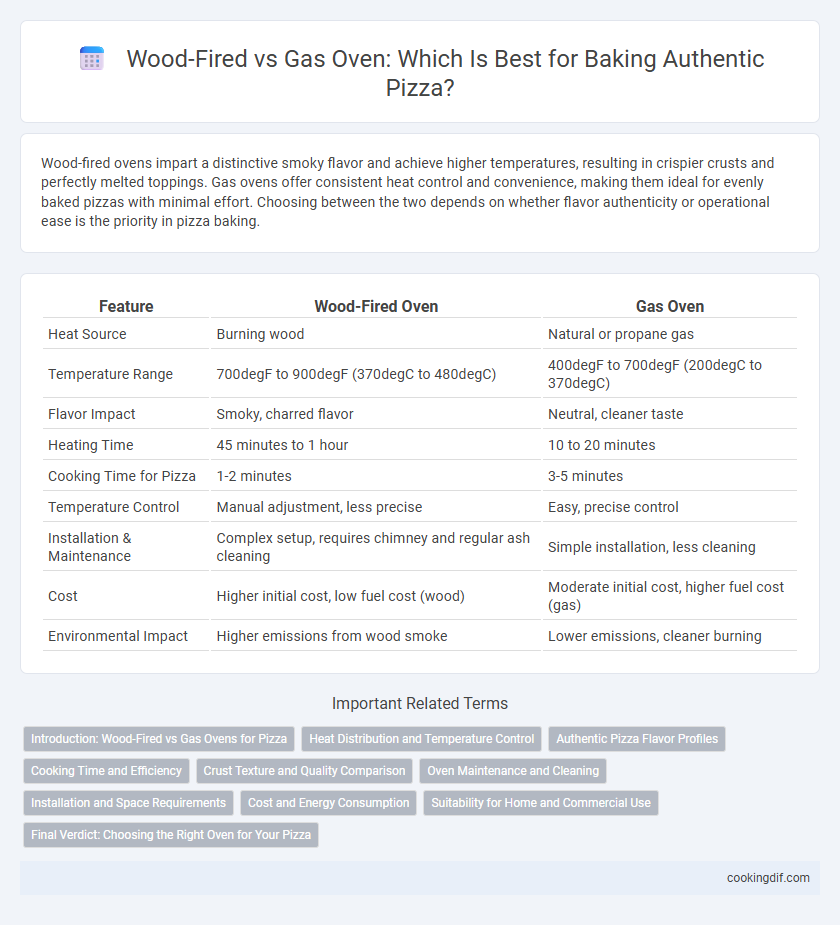Wood-fired ovens impart a distinctive smoky flavor and achieve higher temperatures, resulting in crispier crusts and perfectly melted toppings. Gas ovens offer consistent heat control and convenience, making them ideal for evenly baked pizzas with minimal effort. Choosing between the two depends on whether flavor authenticity or operational ease is the priority in pizza baking.
Table of Comparison
| Feature | Wood-Fired Oven | Gas Oven |
|---|---|---|
| Heat Source | Burning wood | Natural or propane gas |
| Temperature Range | 700degF to 900degF (370degC to 480degC) | 400degF to 700degF (200degC to 370degC) |
| Flavor Impact | Smoky, charred flavor | Neutral, cleaner taste |
| Heating Time | 45 minutes to 1 hour | 10 to 20 minutes |
| Cooking Time for Pizza | 1-2 minutes | 3-5 minutes |
| Temperature Control | Manual adjustment, less precise | Easy, precise control |
| Installation & Maintenance | Complex setup, requires chimney and regular ash cleaning | Simple installation, less cleaning |
| Cost | Higher initial cost, low fuel cost (wood) | Moderate initial cost, higher fuel cost (gas) |
| Environmental Impact | Higher emissions from wood smoke | Lower emissions, cleaner burning |
Introduction: Wood-Fired vs Gas Ovens for Pizza
Wood-fired ovens reach higher temperatures, typically between 800degF and 900degF, creating a crispy crust and smoky flavor ideal for traditional Neapolitan-style pizzas. Gas ovens offer more precise temperature control and consistent heat distribution, making them suitable for commercial pizzerias focused on efficiency and uniform results. Choosing between wood-fired and gas ovens depends on prioritizing authentic flavor and artisanal cooking or operational convenience and consistency.
Heat Distribution and Temperature Control
Wood-fired ovens provide intense, uneven heat that creates a distinctive char and smoky flavor, reaching temperatures above 900degF for a crispy crust and quick cooking. Gas ovens offer more consistent heat distribution and precise temperature control, making it easier to maintain stable cooking conditions and avoid hot spots. Choosing between wood-fired and gas ovens depends on whether a smoky, artisanal result or consistent, controlled baking is prioritized.
Authentic Pizza Flavor Profiles
Wood-fired ovens impart a distinct smoky aroma and char to pizza crusts, enhancing the authentic Neapolitan flavor profile with high-temperature cooking that achieves perfect blistering. Gas ovens offer more consistent temperature control, producing evenly cooked pizzas but lack the unique wood smoke infusion that defines traditional artisanal pizzas. For true authenticity, wood-fired ovens are preferred by pizzaiolos seeking complex, nuanced flavors derived from natural combustion and intense radiant heat.
Cooking Time and Efficiency
Wood-fired ovens reach higher temperatures of 800-900degF, enabling pizzas to cook in just 90 seconds, resulting in a crisp, smoky crust with efficient heat retention. Gas ovens typically operate at lower temperatures around 500-700degF, requiring 3-5 minutes to bake a pizza, offering more precise temperature control and quicker start-up times. Efficiency in wood-fired ovens stems from intense radiant heat and thermal mass, while gas ovens excel in fuel economy and consistent, even cooking.
Crust Texture and Quality Comparison
Wood-fired ovens produce pizzas with a uniquely crispy and smoky crust due to intense, uneven heat that reaches temperatures above 800degF, promoting rapid cooking and slight charring. Gas ovens provide more consistent, controllable heat, resulting in an evenly baked crust that is less smoky but often thicker and softer than wood-fired counterparts. The choice between these ovens significantly impacts crust texture: wood-fired offers a rustic, airy crunch while gas ovens yield a more uniform, chewy base.
Oven Maintenance and Cleaning
Wood-fired pizza ovens require regular removal of ash and soot to maintain heat efficiency and flavor integrity, with chimney cleaning essential to prevent creosote buildup. Gas ovens typically need less frequent deep cleaning, focusing on burners and drip trays to avoid grease accumulation and ensure consistent heat distribution. Proper maintenance of both oven types extends lifespan and enhances pizza quality by ensuring optimal cooking conditions.
Installation and Space Requirements
Wood-fired pizza ovens require a well-ventilated outdoor space and a sturdy foundation due to their heavy masonry construction, making installation more complex and space-intensive. Gas ovens offer more flexibility with easier indoor or outdoor installation, requiring less clearance and minimal ventilation compared to wood-fired ovens. The choice between these ovens often depends on available space, ventilation options, and structural support for optimal pizza baking performance.
Cost and Energy Consumption
Wood-fired pizza ovens generally incur higher upfront costs due to specialized materials and construction but can be more energy-efficient when using sustainably sourced wood. Gas ovens offer lower initial investment and provide consistent heat control, often consuming less energy overall for shorter cooking times. Evaluating energy prices and usage frequency is crucial in determining the most cost-effective option for pizza baking.
Suitability for Home and Commercial Use
Wood-fired ovens provide authentic smoky flavors and high temperatures ideal for artisanal pizzas, making them popular in commercial settings but requiring more space and maintenance, which can challenge home use. Gas ovens offer consistent temperature control, easier operation, and faster startup times, enhancing convenience and efficiency for both home cooks and busy pizzerias. Choosing between wood-fired and gas ovens depends on balancing flavor preferences, operational complexity, and installation space within the intended use environment.
Final Verdict: Choosing the Right Oven for Your Pizza
Wood-fired ovens provide higher temperatures and smoky flavors that enhance traditional Neapolitan pizzas, while gas ovens offer consistent heat control and convenience for diverse pizza styles. For artisanal pizza enthusiasts seeking authentic taste and crispy crusts, wood-fired ovens are ideal. Those prioritizing ease of use and temperature precision benefit from gas ovens that deliver reliable results in various baking environments.
Wood-fired vs gas oven for pizza baking Infographic

 cookingdif.com
cookingdif.com